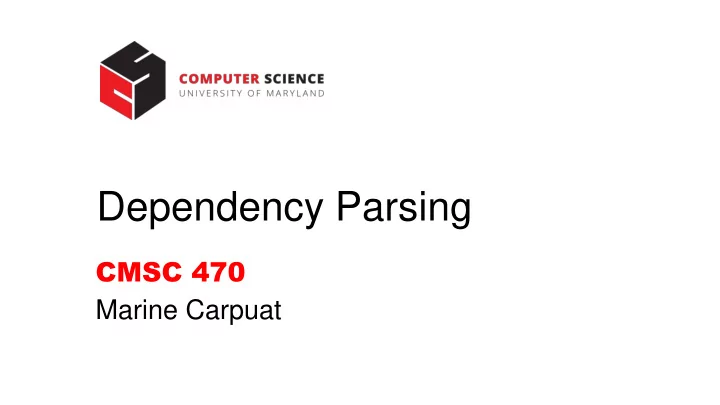

Dependency Parsing CMSC 470 Marine Carpuat
Dependency Grammars • Syntactic structure = lexical items linked by binary asymmetrical relations called dependencies
Example Dependency Parse Dependencies (usually) form a tree: - Connected - Acyclic - Single-head They hid the letter on the shelf Compare with constituent parse… What’s the relation ?
Universal Dependencies project • Set of dependency relations that are • Linguistically motivated • Computationally useful • Cross-linguistically applicable [Nivre et al. 2016] • 100+ dependency treebanks for more than 60 languages universaldependencies.org
Universal Dependencies Illustrated Parallel examples for English, Bulgarian, Czech & Swedish https://universaldependencies.org/introduction.html
Universal Dependencies Design principles • UD needs to be satisfactory on linguistic analysis grounds for individual languages. • UD needs to be good for linguistic typology, i.e., providing a suitable basis for bringing out cross-linguistic parallelism across languages and language families. • UD must be suitable for rapid, consistent annotation by a human annotator. • UD must be suitable for computer parsing with high accuracy. • UD must be easily comprehended and used by a non-linguist, whether a language learner or an engineer with prosaic needs for language processing. We refer to this as seeking a habitable design, and it leads us to favor traditional grammar notions and terminology. • UD must support well downstream language understanding tasks (relation extraction, reading comprehension, machine translation, …). https://universaldependencies.org/introduction.html
Syntax in NLP • Syntactic analysis can be useful in many NLP applications • Grammar checkers • Dialogue systems • Question answering • Information extraction • Machine translation • … • Sequence models can go a long way but syntactic analysis is particularly useful • In low resource settings • In tasks where precise output structure matters
Syntactic analysis can help NLP tasks by After much economic progress over the years, the country has … The country, which has made much economic progress over the years, still has … Helping generalization (e.g., by Providing scaffolding for semantic capturing long-distance dependencies) analysis (and representing or resolving ambiguity)
Data-driven dependency parsing Goal: learn a good predictor of dependency graphs Input: sentence Output: dependency graph/tree G = (V,A) Can be framed as a structured prediction task - very large output space - with interdependent labels 2 dominant approaches: transition-based parsing and graph-based parsing
Transition-based dependency parsing • Builds on shift-reduce parsing [Aho & Ullman, 1972] • Configuration • Stack • Input buffer of words • Set of dependency relations • Goal of parsing • find a final configuration where • all words accounted for • Relations form dependency tree
Defining Transitions • Transitions • Are functions that produce a new configuration given current configuration • Parsing is the task of finding a sequence of transitions that leads from start state to desired goal state • Start state • Stack initialized with ROOT node • Input buffer initialized with words in sentence • Dependency relation set = empty • End state • Stack and word lists are empty • Set of dependency relations = final parse
Arc Standard Transition System defines 3 transition operators [Covington, 2001; Nivre 2003] SHIFT • Remove word at head of input buffer • Push it on the stack LEFT-ARC • create head-dependent relation between word at top of stack and 2 nd word (under top) • remove 2 nd word from stack RIGHT-ARC • Create head-dependent relation between word on 2 nd word on stack and word on top • Remove word at top of stack
Arc standard transition systems • Preconditions • ROOT cannot have incoming arcs • LEFT-ARC cannot be applied when ROOT is the 2 nd element in stack • LEFT-ARC and RIGHT-ARC require 2 elements in stack to be applied
Transition-based Dependency Parser Properties of this algorithm: - Linear in sentence length - A greedy algorithm - Output quality depends on oracle
Exercise: find a sequence of transitions to generate this parse SHIFT • Remove word at head of input buffer • Push it on the stack LEFT-ARC • create head-dependent relation between word at top of stack and 2 nd word (under top) • remove 2 nd word from stack RIGHT-ARC • Create head-dependent relation between word on 2 nd word on stack and word on top • Remove word at top of stack
Transition-Based Parsing Illustrated
Where do we get an oracle? • Multiclass classification problem • Input: current parsing state (e.g., current and previous configurations) • Output: one transition among all possible transitions • Q: size of output space? • Supervised classifiers can be used • E.g., perceptron • Open questions • What are good features for this task? • Where do we get training examples?
Generating Training Examples • What we have in a treebank • What we need to train an oracle • Pairs of configurations and predicted parsing action
Generating training examples • Approach: simulate parsing to generate reference tree Additional condition on RightArc makes sure a • Given word is not removed from • A current config with stack S, dependency relations Rc stack before its been • A reference parse (V,Rp) attached to all its • Do dependent
Let’s try it out
Features • Configuration consist of stack, buffer, current set of relations • Typical features • Features focus on top level of stack • Use word forms, POS, and their location in stack and buffer
Features example • Given configuration • Example of useful features
Features example
Recommend
More recommend